History
Die Schoho’s und die Beduan bei Massua [The Saho and the Beduins of Massawa] (1859)
by Werner Munzinger
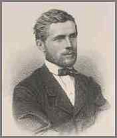
 From Zeitschrift für Allgemeine Erdkunde, 1859, 6 (2): 89-110.
From Zeitschrift für Allgemeine Erdkunde, 1859, 6 (2): 89-110.
The swiss Werner Munzinger (1832-1875) studied natural science, Oriental languages, and history. He became governor of Massawa in 1871.
Source: https://archive.org/details/zeitschriftfural06zeit
Studien ueber Ost-Afrika. I. Das Saho-Volk [Studies on East-Africa. I. The Saho people] (1877)
by Leo Reinisch
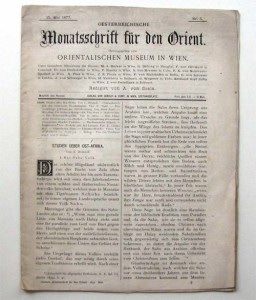
 From Österreichische Monatsschrift für den Orient, 1877, 5: 65-73.
From Österreichische Monatsschrift für den Orient, 1877, 5: 65-73.
This articles of Leo Reinisch, is the most important article on the Saho history and culture written in the XIX century.
Al Rágali [To the Rágali ] (1903)
by Carlo Conti Rossini

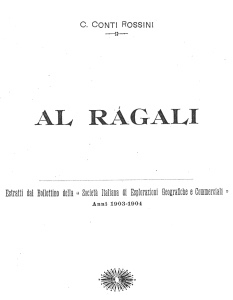 Conti Rossini, C. (1903) “Al Rágali”, Estratti dal Bollettino della Società Italiana di Esplorazioni Geografiche e Commerciali, anni 1903-1904. Milano: Stabilimento Tipografico Bellini.
Conti Rossini, C. (1903) “Al Rágali”, Estratti dal Bollettino della Società Italiana di Esplorazioni Geografiche e Commerciali, anni 1903-1904. Milano: Stabilimento Tipografico Bellini.
The record of a travel made in 1902 by Carlo Conti Rossini in the area around the river Cindeeli/Raagali, between Eritrea and Ethiopia. It contains many information about the land, the history (also genealogies), the customs and the language of the Saho.
Popolazione di lingua Saho [People of Saho language] (1935)
by Alberto Pollera
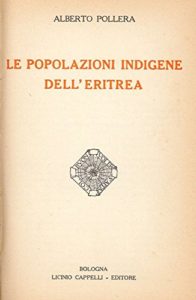
 From Le popolazioni indigene dell’Eritrea [The native peoples of Eritrea] 1935. Pp. 262-276. Bologna: Cappelli.
From Le popolazioni indigene dell’Eritrea [The native peoples of Eritrea] 1935. Pp. 262-276. Bologna: Cappelli.
One of the most complete tentative description of the origin and subdivisions of the Saho people groups made during the Italian colonisation. An English version of the book was printed in 1999 by Red Sea Press (translated by Linda Lappin).
Studi su popolazioni dell’Etiopia [Studies on populations of Ethiopia] (1910)
by Carlo Conti Rossini
 From Rivista degli Studi Orientali, 1910, vol. 3, 4: 849-900.
From Rivista degli Studi Orientali, 1910, vol. 3, 4: 849-900.
The article (first of three parts) presents some traditions about the origin of the Irob, the Hazo and the Tharuuca Saho divisions. The description is in Italian with some texts in Amharic, Tigrinya and Arabic.
Peoples of the Horn of Africa. The Saho (1955)
by I. M. Lewis
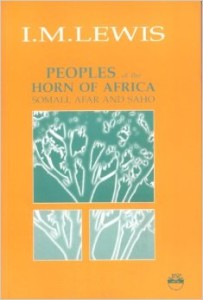
 From Lewis, I. M. (1955) Peoples of the Horn of Africa: Somali, Afar and Saho. Oxford: Oxford University Press. Pp. 174-76.
From Lewis, I. M. (1955) Peoples of the Horn of Africa: Somali, Afar and Saho. Oxford: Oxford University Press. Pp. 174-76.
Reprinted in 1998 by Red Sea Press.
Source: https://archive.org/details/peoplesofthehorn007763mbp
La généalogie des trios tribes Irob chrétiennes d’après des documents de Gunda Gundié [The genealogy of three Irob Christian tribes from the documents of Gunda Gundie] (1985)
by Gigar Tesfaye
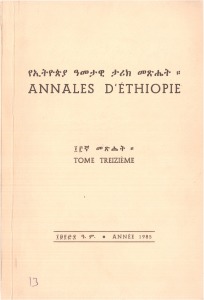
 From Annales d’Ethiopie. Volume 13, 1985. Pp. 57-66.
From Annales d’Ethiopie. Volume 13, 1985. Pp. 57-66.
Source: http://www.persee.fr/web/revues/home/prescript/article/ethio_0066-2127_1985_num_13_1_919
ታሪክ ኢሮብ (ሓፂር መግለፂ) [Tarik Irob (ḥaśśir mägläśi) History of Irob (A short description)] (1993 Ethiopian calendar = 2000)
by Abba Täsfay Mädḥǝn
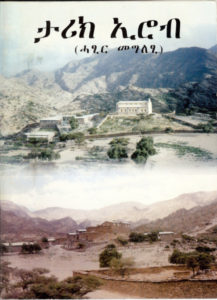
 The book is written in Tigrinya. It contains articles on the Irob history and culture, as well as a list of 335 Irob proverbs in Saho language, with Tigrinya translation.
The book is written in Tigrinya. It contains articles on the Irob history and culture, as well as a list of 335 Irob proverbs in Saho language, with Tigrinya translation.
Source: https://irrob.org/irob-history/tarik-irob-by-abba-tesfay-medhin/
Grand muftí, érudit et nationaliste érythréen. Note sur la vie et l’oeuvre de cheikh Ibrâhîm al-Mukhtâr (1909-1969) [The Grand Mufti, Eritrean erudite and nationalist: notes on the life and works of the Sheikh Ibrâhîm al-Mukhtâr (1909-1969)] (2002)
by Jonathan Miran
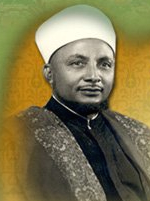
 From: Chroniques yéménites. 10, 2002 (online version)
From: Chroniques yéménites. 10, 2002 (online version)
Abstract: Appointed the Grand Mufti of Eritrea by the Italians in 1939, the Sheikh Ibrâhîm al-Mukhtâr occupied an important place in the heart of the Eritrean Muslim community, until his death. A scholar and writer, he was convinced of the singularity of his country’s history, favored the development and modernization of its Muslim institutions and took an active role in the nationalist struggle, especially against Ethiopian presence in Eritrea. His biography adds a different perspective on a crucial period of Eritrea’s modern history.
Source: http://cy.revues.org/126
An Ethno-Historical Survey of the Irob Agro-Pastoralists of Northeastern Tigray (Ethiopia) (2003)
by Tsegay Berhe Gebrelibanos

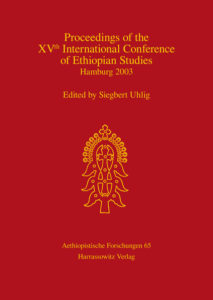 This is an online available version of the article published in Siegbert Uhlig (ed.) Proceedings of the 15th International Conference of Ethiopian Studies, Hamburg 2003, pp. 372-381. Wiesbaden: Harrasowitz.
This is an online available version of the article published in Siegbert Uhlig (ed.) Proceedings of the 15th International Conference of Ethiopian Studies, Hamburg 2003, pp. 372-381. Wiesbaden: Harrasowitz.
Abstract (from the published article): The article presents a brief ethno-historical survey of the Irob people of eastern Tǝgray, ʿAgamä. Irobland, being a very small area with a population of about 20,000, is a striking micro-model of intensive ethno-historical interactions, which characterize the area of ʿAgamä as a whole. The Irob have become a bi-lingual community with Sāho and Tǝgrǝñña being spoken by most of them. Irob socio-political organization, still less studied, appears to have been based on an egalitarian system where power largely rested in the public assembly which in turn delegated it to the council of elders. The Irob retained their local political autonomy until the 18th cent., but since then they increasingly began to participate in the political affairs of Tǝgray. Their representative, Däǧǧazmač Subagadis (r. 1822–31), grew so ambitious that he challenged the power of the Yäǧǧu Oromo warlords at Däbrä Abbay (1831). Though his bid to assume the power brokerage of Gondärine Imperial politics failed, his descendants ruled ʿAgamä until the 1974 Revolution.
Source: https://sites.google.com/site/irroborg/history-of-irob/irob-history
ʿAsaurta (2006)
by Didier Morin
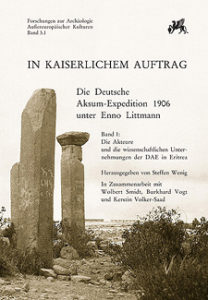
 From Steffen Wenig (Ed), IN KAISERLICHEM AUFTRAG. Die Deutsche Aksum-Expedition 1906 unter Enno Littmann. Aichwald : Linden Soft, 2006: pp. 77-82
From Steffen Wenig (Ed), IN KAISERLICHEM AUFTRAG. Die Deutsche Aksum-Expedition 1906 unter Enno Littmann. Aichwald : Linden Soft, 2006: pp. 77-82
A short sketch of the Casawurta territory, subdivisions, history and language.
Irob (2007)
The Customary Law of the Akele Guzai Muslim [the Saho] (2009)
by Abdulkader Saleh Mohammed
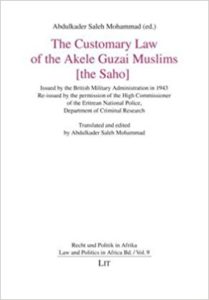 Lit Verlag, Münster, 2009, pp. 74 + 34 Arabic Text
Lit Verlag, Münster, 2009, pp. 74 + 34 Arabic Text
This book presents the first English translation of the Saho customary law in Eritrea, with an introduction discussing the historical and socio-cultural background of the Saho community and the role of traditional conflict mediation in contemporary Eritrea. The law has a strong communal character and rules both economic activities and social life. It was orally transmitted from generation to generation and printed in 1943, of which only one copy is known. It is based on local traditional and Islamic law and its principles are respected up to the present day. The volume is a significant contribution to the study of Eritrean customary law, which presents an important cultural heritage.
The book is not available for the download, but its contents can be partially viewed at: https://books.google.it/books?id=LN-ncVoNpSAC&dq=The+Customary+Law+of+the+Akele+Guzai+Muslim+%5Bthe+Saho%5D&hl=it&source=gbs_navlinks_s
Borderless world vs borders as walls: Insight from a borderland group in Northern Ethiopia (2012)
by Alexandra Magnólia Dias
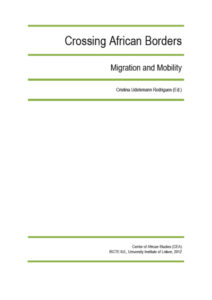
 From: Crossing African Borders: Migration and Mobility. Center of African Studies (CEA)/ISCTE-IUL, University Institute of Lisbon. Lisbon, 2012 (Digital Edition).
From: Crossing African Borders: Migration and Mobility. Center of African Studies (CEA)/ISCTE-IUL, University Institute of Lisbon. Lisbon, 2012 (Digital Edition).
A version of this article (in Spanish) has been published in Nova Africa, 27 (2012). See: https://dialnet.unirioja.es/ejemplar/404890
Source: https://repositorio.iscte-iul.pt/handle/10071/4519
The Saho of Eritrea: Ethnic Identity and National Consciousness (2013)
by Abdulkader Saleh Mohammed
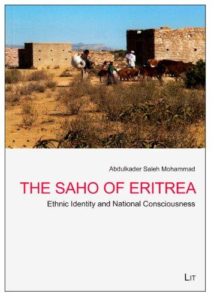 Lit Verlag, Münster, 2013, pp. 382.
Lit Verlag, Münster, 2013, pp. 382.
This book presents an analysis of the identity of the agro-pastoral Saho community in Eritrea, which was cemented during centuries of confrontation with Abyssinian rulers and by their rebellion against external domination. It examines the emergence of the Saho’s national consciousness and the process of political identity formation during the British Military Administration in competition with the pro-Ethiopian Unionist Party. The book describes the active participation of the Saho in the national liberation struggle of Eritrea, and it evaluates the impact of post-independence policies of the Eritrean People’s Liberation Front/People’s Front for Democracy and Justice on the Saho community. (Series: African Politics / Politiques Africaines – Vol. 5).
The book is not available for the download, but its contents can be partially viewed at: https://books.google.it/books/about/The_Saho_of_Eritrea.html?id=jwjX_yVT7AoC&redir_esc=y
Here an excerpt of the chapter “The Settlement Patterns and Tribal Structure“
The Question of Structural Violence on the Saho people of Eritrea, in spite of their important role during the Eritrean Struggle for Independence (2015)
by Roman Abdellah Esmail
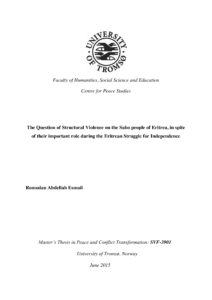
 Master’s Thesis in Peace and Conflict Transformation – University of Tromsø, Norway, June 2015
Master’s Thesis in Peace and Conflict Transformation – University of Tromsø, Norway, June 2015
(Abstract) The thesis focuses on discovering incidents of the structural violence on the Saho of Eritrea under the Eritrean PFDJ government. It is mainly stressed on the government policies, especially language and land and how the policies undermined the democratic rights of the Saho people. At the same time, it attempts to shed light on the subsequent suppressive attitudes of the government and its overall impacts on the Saho people and the consequences. To meet the objectives, the study relied on an in-depth interviewing of the Saho refugees in Ethiopia. Sixteen qualitative interviewing was conducted. The related documents were also used. As a conceptual framework for analysis, the study uses theories of the structural violence. The thesis also referred to the approaches of minority rights endorsed by the international and UN organizations.
The research findings are largely qualitative anecdotal evidence in type mainly from the perspectives of the Saho people. According to the findings frustrations are commonly observed among all Saho informants because of the marginalization and government negligence. The Saho see themselves as subordinated and poorly represented in decision making processes in matters that affect their very interest and livelihood. As a result, most of them entirely dissociate themselves from the government. The Saho people’s attitude towards the government’s language (mother tongue education) and land policy was in general negative. Forcible imposition of mother tongue education and its ineffective role, lack of consultation and participation of the Saho elites in the affairs concerned to them, discriminations involved in land allocation process, negligence of the pastoral Saho and forced government relocation programs are among the discovered incidents of the structural violence. It was also accompanied with further suppression and intimidation.
Comparing to their highland neighboring Tigrigna ethnic group, the Saho are the most marginalized society. The long-term effects of government’s maltreatment, as the findings indicate, are extreme poverty and unequal survival chances between the Saho and their immediate neighboring highland group. Higher illiteracy, morbidity and unemployment rate is commonly seen among the Saho. Moreover, several Saho families found themselves in a hard position to cope with difficult situation. As a result, migration, family disintegration, intergenerational welfare dependency, humiliation, undermining of their wellbeing and self- esteem were among the impacts. Many were lured by the government to military and others enticed to accept government programs. The Saho people in remote areas are extremely vulnerable and suffering groups in this case. The situation is heading to further worse. As a consequence of all, finally, the situations transformed to violent conflict between the government and the Saho people displayed obviously since 2008/2009.
At the end the study suggests recommendations how to overcome the structural violence against the Saho people in particular and making Eritrea just, egalitarian and an inclusive for every Eritrean citizens in general.
Source: https://munin.uit.no/handle/10037/8284
Between Migration, Integration and Marginalisation: Exploring the Historical Dynamics of the Saho Muslim Settlements in Tǝgray (2016)
by Fesseha Berhe
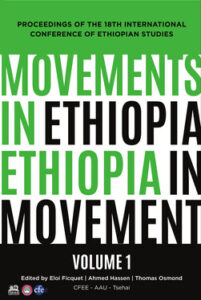
 from: Ficquet, E., Amed Hassen and Osmond T. (eds.) (2016) Movements in Ethiopia. Ethiopia in Movement. Proceedings of the 18th International Conference of Ethiopian Studies, vol. 1. Addis Abeba: Tsehai. Pp. 349-357.
from: Ficquet, E., Amed Hassen and Osmond T. (eds.) (2016) Movements in Ethiopia. Ethiopia in Movement. Proceedings of the 18th International Conference of Ethiopian Studies, vol. 1. Addis Abeba: Tsehai. Pp. 349-357.
Source: https://books.openedition.org/cfee/1197?lang=it
Il contributo di Carlo Conti Rossini alla conoscenza dei Saho di Eritrea ed Etiopia [The contribution of Carlo Conti Rossini to the knowledge of the Saho of Eritrea and Ethiopia](2021)
by Moreno Vergari
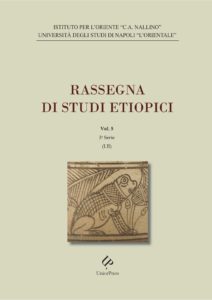
 From: Rassegna di Studi Etiopici, Vol. 5, 3a serie (LII): 93-112
From: Rassegna di Studi Etiopici, Vol. 5, 3a serie (LII): 93-112
(Abstract) This article aims to show how the publications of Conti Rossini dedicated to the study of history, territory, customary law and language of the Saho groups still con- stitute a precious and essential contribution to the knowledge of this population. Par- ticular attention is paid to some references to the oldest citations of names of Saho groups, reported and commented by Conti Rossini, some customs and songs and po- ems related to the traditions of the Saho. Some remarks are also made to his main contribution to the knowledge of a northern variant of the Saho language.




